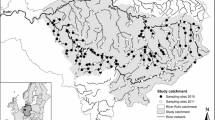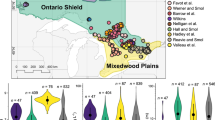Abstract
Modern assessment and monitoring of aquatic ecosystems is increasingly based on biota and the “reference condition” approach, in which the observed values (O) of biological variables are compared to those expected in the absence of human disturbance (E). To use this approach, correct estimation and validation of reference conditions are critical. Because appropriate modern or historical data are never available for this approach, palaeolimnological data offer an alternative. We used a calibration data set from 73 profundal sites in semi-pristine Finnish lakes to construct a regression model for estimating expected values for the chironomid Benthic Quality Index (BQI)—a macroinvertebrate metric widely used in bioassessment—from environmental variables that are insensitive to human disturbance. For comparison, reference values were estimated using the European legislative rationale based on a priori lake typology. Performance of the alternative approaches was assessed by internal ‘leave-one-out’ cross-validation using the calibration set and by external cross-validation using independent palaeolimnological data on BQI values representing the historical pristine status of 24 lake basins. Additionally, for 19 of these sites, which vary in their degree of human impact, the ratio of present BQI to that in pristine condition, which shows the degree of actual change, if any, was calculated from palaeolimnological data and compared with the O/E ratios based on the present chironomid data and estimated E. A linear regression model with mean depth and mean/maximum depth ratio as independent variables estimated the reference values of BQI much closer to the observed ones (r 2 = 0.58, RMSEP = 0.65 and r 2 = 0.71 RMSEP = 0.55; for internal and external cross-validation, respectively) than did the typology approach (r 2 = 0.28, RMSEP = 0.86; r 2 = 0.10, RMSEP = 0.97). The regression approach also yielded O/E ratios more similar to the actual ones (r 2 = 0.79, RMSEP = 0.09) than did the typology approach (r 2 = 0.62, RMSEP = 0.23). Our results strongly support the use of lake morphometric variables and modelling instead of categorical lake typology for the establishment of reference conditions for profundal macroinvertebrate communities and demonstrate the utility of palaeolimnological data in the validation of reference values and assessment methods.




Similar content being viewed by others
References
Andersen JH, Conley DJ, Hedal S (2004) Palaeoecology, reference conditions and classification of ecological status: the EU water framework directive in practice. Mar Pollut Bull 49:283–290
Anderson NH, Battarbee RW (1994) Aquatic community persistence and variability: a palaeolimnological perspective. In: Giller PS, Hildrew AG, Raffaelli D (eds) Aquatic ecology: scale pattern and process. Blackwell Scientific, Oxford, pp 233–259
Aroviita J, Koskenniemi E, Kotanen J, Hämäläinen H (2008) A priori typology-based prediction of benthic macroinvertebrate fauna for ecological classification of rivers. Environ Manage 42:894–906
Aroviita J, Mykrä H, Muotka T, Hämäläinen H (2009) Influence of geographical extent on typology- and model-based assessments of taxonomic completeness of river macroinvertebrates. Freshw Biol 54:1774–1787
Bailey R, Norris RH, Reynoldson TB (2004) Bioassessment of freshwater ecosystems: using the reference condition approach. Springer, New York
Bennion H, Fluin J, Simpson GL (2004) Assessing eutrophication and reference conditions for Scottish freshwater lochs using subfossil diatoms. J Appl Ecol 41:124–138
Brinkhurst RO (1974) The benthos of lakes. Blackburn Press, Caldwell
Davies SP, Jackson SK (2006) The biological condition gradient: a descriptive model for interpreting change in aquatic ecosystems. Ecol Appl 16:1251–1266
Davy-Bowker J, Clarke RT, Johnson RK, Kokes J, Murphy JF, Zahradkova S (2006) A comparison of the European water framework directive physical typology and RIVPACS-type models as alternative methods of establishing reference conditions for benthic macroinvertebrates. Hydrobiologia 566:91–105
Efron B, Gong G (1983) A leisure look at the bootstrap, the jackknife, and cross-validation. Am Stat 37:36–48
European Commission (2000) Directive 2000/60/EC 2000. Establishing a framework for Community action in the field of water policy. Off J Eur Communities L327(1):1–72
European Commission (2003) Common implementation strategy for the water framework directive (2000/60/EC). Guidance document no. 10 river and lakes—Typology, reference conditions and classification systems. Office for Official Publications of the European Communities, Luxembourg
Håkanson L (1981) A manual of lake morphometry. Springer, Berlin
Hawkins CP (2006) Quantifying biological integrity by taxonomic completeness: its utility in regional and global assessments. Ecol Appl 16:1277–1294
Heiri O (2004) Within-lake variability of subfossil chironomid assemblages in shallow Norwegian lakes. J Paleolimnol 32:67–84
Honkanen V, Laitinen K, Meriläinen JJ (2004) Saarijärven mahtava Pyhäjärvi. City of Saarijärvi, Saarijärvi
Hughes RM (1995) Defining Acceptable Biological Status by Comparing with Reference Conditions. In: Davis WS, Simon TP (eds) Biological assessment and criteria tools for water resource planning and decision making. Lewis Publishers, Boca Raton, pp 31–47
Hynynen J, Palomäki A, Meriläinen JJ, Witick A, Mäntykoski K (2004) Pollution history and recovery of a boreal lake exposed to a heavy bleached pulping effluent load. J Paleolimnol 32:351–374
Ilyashuk B, Ilyashuk E, Dauvalter V (2003) Chironomid responses to long-term metal contamination: a palaeolimnological study in two bays of Lake Imandra, Kola Peninsula, Northern Russia. J Paleolimnol 30:217–230
Itkonen A, Marttila V, Meriläinen JJ, Salonen V (1999) 8000-year history of palaeoproductivity in a large boreal lake. J Paleolimnol 21:271–294
Johnson RK (1996) The indicator concept in freshwater biomonitoring. In: Cranston P (ed) Chironomids: from genes to ecosystems. CSIRO, Canberra, Australia, pp 11–27
Jyväsjärvi J, Tolonen KT, Hämäläinen H (2009) Natural variation of profundal macroinvertebrate communities in boreal lakes is related to lake morphometry: implications for bioassessment. Can J Fish Aquat Sci 66:589–601
Kansanen PH, Paasivirta L, Väyrynen T (1990) Ordination analysis and bioindices based on zoobenthos communities used to assess pollution of a lake in southern Finland. Hydrobiologia 202:153–170
Kauppila T, Moisio T, Salonen V-P (2002) A diatom-based inference model for autumn epilimnetic total phosphorus concentration and its application to a presently eutrophic boreal lake. J Paleolimnol 27:261–273
Kurek J, Cwynar LC (2009) Effects of within-lake gradient on the distribution of fossil chironomids from maar lakes in western Alaska: implications for environmental reconstructions. Hydrobiologia 623:37–52
Leira M, Jordan P, Taylor D, Dalton C, Bennion H, Rose N, Irvine K (2006) Assessing the ecological status of candidate reference lakes in Ireland using palaeolimnology. J Appl Ecol 43:816–827
Mazor RD, Reynoldson TB, Rosenberg DM, Resh VH (2006) Effects of biotic assemblage, classification, and assessment method on bioassessment performance. Can J Fish Aquat Sci 63:394–411
Meriläinen JJ, Hamina V (1993) Recent environmental history of a large, originally oligotrophic lake in Finland: a palaeolimnological study of chironomid remains. J Paleolimnol 9:129–140
Meriläinen JJ, Hynynen J, Palomäki A, Reinikainen P, Teppo A, Granberg K (2000) Importance of diffuse nutrient loading and lake level changes to the eutrophication of an originally oligotrophic boreal lake: a palaeolimnological diatom and chironomid analysis. J Paleolimnol 24:251–270
Meriläinen JJ, Hynynen J, Palomäki A, Veijola H, Witick A, Mäntykoski K, Granberg K, Lehtinen K (2001) Pulp and paper mill pollution and subsequent ecosystem recovery of a large boreal lake in Finland: a paleolimnological analysis. J Paleolimnol 26:11–35
Meriläinen JJ, Hynynen J, Palomäki A, Mäntykoski K, Witick A (2003) Environmental history of an urban lake: a palaeolimnological study of Lake Jyväsjärvi, Finland. J Paleolimnol 30:387–406
Miettinen JO, Hämäläinen H, Simola H (2002) Iisalmen reitin Onkiveden luonnontilan arviointi paleolimnologisilla analyyseillä–vesidirektiivin toteuttamisen pilottitutkimus. In: Grönlund E, Viljanen M, Juvonen P, Holopainen IJ (eds) Suurjärviseminaari 2001–Ympäristö ja Yhteiskunta. University of Joensuu, Joensuu, pp 345–351
Miettinen JO, Kukkonen M, Simola H (2005) Hindcasting baseline values for water colour and total phosphorus concentration in lakes using sedimentary diatoms–implications for lake typology in Finland. Boreal Environ Res 10:31–43
Neale MW, Rippey B (2008) A comparison of environmental and biological site classifications for the prediction of macroinvertebrate communities of lakes in Northern Ireland. Aquat Conserv Mar Freshw Ecosyst 18:729–741
Paasivirta L (1989) Pohjaeläimistötutkimuksen liittäminen järvisyvännealueiden seurantaan. Report no. 164, Vesi- ja ympäristöhallitus
Reynoldson TB, Bailey RC, Day KE, Norris RH (1995) Biological guidelines for freshwater sediment based on BEnthic Assessment of SedimenT (the BEAST) using a multivariate approach for predicting biological state. Aust J Ecol 20:198–219
Reynoldson TB, Norris RH, Resh VH, Day KE, Rosenberg DM (1997) The reference condition: a comparison of multimetric and multivariate approaches to assess water-quality impairment using benthic macroinvertebrates. J North Am Benthol Soc 16:833–852
Saether OA (1979) Chironomid communities as water quality indicators. Holarctic Ecol 2:65–74
Sandman O, Meriläinen JJ, Simola H, Hynynen J, Lahtinen J, Marttila V, Reinikainen P (2000) Short-code paleolimnological investigation of Lake Pihlajavesi in the Saimaa Lake complex, eastern Finland: assessment of habitat quality of an endemic and endangered seal population. J Paleolimnol 24:317–329
Simola H, Meriläinen JJ, Sandman O, Marttila V, Karjalainen H, Kukkonen M, Julkunen-Tiitto R, Hakulinen J (1996) Palaeolimnological analyses as information source for large lake biomonitoring. Hydrobiologia 322:283–292
Smol JP (1992) Paleolimnology: an important tool for effective ecosystem management. J Aquat Ecosyst Health 1:49–58
Stoddard JL, Larsen DP, Hawkins CP, Johnson RK, Norris RH (2006) Setting expectations for the ecological condition of streams: the concept of reference condition. Ecol Appl 16:1267–1276
Stone M (1974) Cross-validatory choice and assessment of statistical predictions. J Roy Stat Soc 36:111–147
Veijola H, Meriläinen JJ, Marttila V (1996) Sample size in the monitoring of benthic macrofauna in the profundal of lakes: evaluation of the precision of estimates. Hydrobiologia 322:301–315
Vuori KM, Bäck S, Hellsten S, Karjalainen SM, Kauppila P, Lax HG, Lepistö L, Londesborough S, Mitikka S, Niemelä P, Niemi J, Perus J, Pietiläinen OP, Pilke A, Riihimäki J, Rissanen J, Tammi J, Tolonen K, Vehanen T, Vuoristo H, Westberg V (2006) The basis for typology and ecological classification of water bodies in Finland. Report no. 807, Finnish Environment Institute, Yliopistopaino, Helsinki (in Finnish with English abstract)
Wallach D, Goffinet B (1989) Mean squared error of prediction as a criterion for evaluating and comparing system models. Ecol Modell 44:299–306
Wiederholm T (1980) Use of benthos in lake monitoring. J Water Pollut Control Fed 52:537–547
Wiederholm T, Eriksson L (1979) Subfossil chironomids as evidence of eutrophication in Ekoln Bay, central Sweden. Hydrobiologia 62:195–208
Wright JF, Sutcliffe DW, Furse MT (2000) Assessing the biological quality of fresh waters RIVPACS and other techniques. Freshwater Biological Association, Ambleside
Yuan LL, Hawkins CP, Van Sickle J (2008) Effects of regionalization decisions on an O/E index for the US national assessment. J North Am Benthol Soc 27:892–905
Acknowledgments
The preparation of this manuscript was financially supported by the Maj and Tor Nessling Foundation and the Ella and Georg Ehrnrooth Foundation. Professor Roger Jones kindly provided helpful comments for the manuscript.
Author information
Authors and Affiliations
Corresponding author
Rights and permissions
About this article
Cite this article
Jyväsjärvi, J., Nyblom, J. & Hämäläinen, H. Palaeolimnological validation of estimated reference values for a lake profundal macroinvertebrate metric (Benthic Quality Index). J Paleolimnol 44, 253–264 (2010). https://doi.org/10.1007/s10933-009-9401-0
Received:
Accepted:
Published:
Issue Date:
DOI: https://doi.org/10.1007/s10933-009-9401-0




